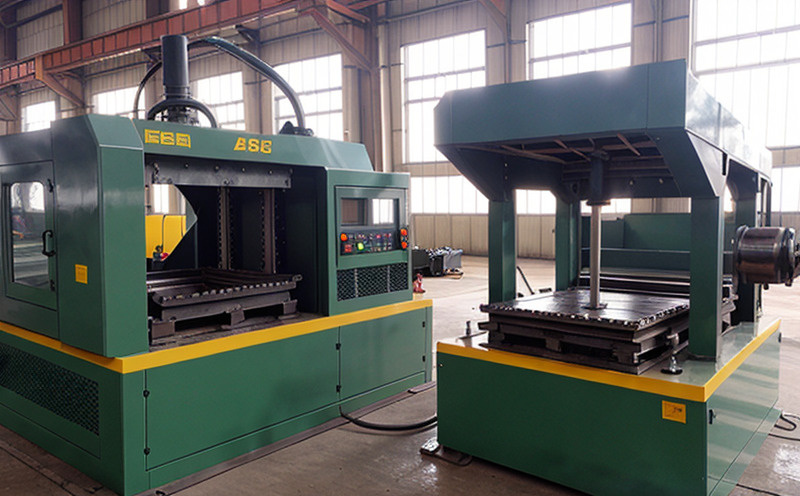ASTM A388 Ultrasonic Examination of Forged Steels
The ASTM A388 standard specifies procedures for inspecting forged steels using ultrasonic methods. This non-destructive testing (NDT) technique is crucial in the industrial manufacturing sector, particularly for ensuring that critical components are free from defects which could compromise their integrity and safety.
Forged steel parts are commonly used in applications where high strength and durability are essential, such as in aircraft engines, heavy machinery, automotive components, and structural elements. The ASTM A388 ultrasonic examination ensures these components meet the stringent quality standards required for such critical uses. By employing this technique, manufacturers can verify that their products comply with industry specifications.
The process involves transmitting high-frequency sound waves into the material being tested. These waves interact with internal structures and defects within the component. Any anomalies or flaws are detected based on changes in the reflected or transmitted signals. Ultrasonic testing is highly sensitive, capable of identifying very small flaws that might otherwise go unnoticed.
The ASTM A388 standard outlines specific parameters for the ultrasonic examination, including:
- Frequency range
- Type of probes and their specifications
- Test procedures to be followed
- Data recording and analysis methods
The testing process begins with thorough preparation of the component. This may involve cleaning the surface, ensuring it is free from contaminants that could interfere with the ultrasonic signal. Next, an appropriate coupling agent or gel is applied to ensure good transmission between the probe and the material being inspected.
During the inspection, the probe is carefully positioned over the area of interest on the component. The operator then moves the probe across the surface, generating a continuous stream of ultrasonic signals. A computer system processes these signals in real-time, providing immediate feedback on any anomalies detected.
The results of the ASTM A388 examination are critical for quality assurance and safety compliance. Defects identified during this process can be addressed by reworking or scrapping the component as necessary. This ensures that only high-quality parts enter service, enhancing overall product reliability and safety.
Quality and Reliability Assurance
The ASTM A388 ultrasonic examination plays a pivotal role in maintaining quality and reliability within industrial manufacturing processes. By detecting internal flaws early on, the testing process allows for timely interventions that prevent the propagation of defects into larger issues.
Quality managers rely heavily on such non-destructive testing methods to ensure compliance with international standards like ISO 9001:2015 and ASME Section VIII. The ability to inspect components without causing damage ensures that production processes remain efficient, minimizing downtime and reducing costs associated with rework or scrap.
Reliability engineers also benefit from ASTM A388 testing as it helps in validating the integrity of critical parts. This is particularly important for industries like aerospace, where even minor flaws can have catastrophic consequences. By adhering to the ASTM A388 standard, manufacturers can ensure that their products meet the stringent reliability requirements set by organizations such as NASA and FAA.
| Parameter | Description |
|---|---|
| Frequency Range | 1.25 MHz to 40 MHz, depending on the probe and application. |
| Type of Probes | Curved or straight probes, depending on the geometry of the component. |
| Data Analysis Methods | Signal processing algorithms to identify and quantify defects. |
Environmental and Sustainability Contributions
The ASTM A388 ultrasonic examination contributes positively to environmental sustainability by promoting the use of non-destructive testing methods. This reduces waste associated with reworking or scrapping defective components, thereby minimizing material consumption and energy usage in production processes.
By ensuring that only high-quality forged steel parts enter service, this inspection method helps extend the lifespan of machinery and structures. This leads to reduced maintenance costs and lower environmental impact over the long term. Compliance with ASTM A388 also ensures that products meet regulatory standards, further enhancing their sustainability credentials.
The use of ultrasonic testing aligns with broader industrial efforts towards sustainable manufacturing practices. It supports initiatives aimed at reducing carbon footprints by optimizing production processes and ensuring higher product quality from the outset. This contributes to a more efficient and environmentally responsible supply chain.
Use Cases and Application Examples
| Application | Description |
|---|---|
| Aircraft Engine Parts | Critical components like turbine blades and engine casings are inspected to ensure they meet stringent safety standards. |
| Automotive Components | Roadworthy parts such as axles, transmission gears, and suspension systems undergo testing for durability and integrity. |
| Construction Equipment | Lifting arms, boom sections, and other structural elements are checked to prevent failures in heavy machinery. |
| Agricultural Machinery | Forged components like gears and shafts in tractors and harvesters are inspected for potential flaws. |





